Thinqua®
__
Neurodynamic Information
Science
__
The NIS Framework: the work environment designed to train the most advanced functions of your Mind, hack your life and realize yourself.
"Your life is the product of what you write into your Mind. Rewrite your identity and you will have rewritten the script of your life.
I've designed the NIS Framework to do this. "
__________
.
I'm Andrea Mele Motta,
Thinqua® founder and creator of the NIS Framework .
___________
I literally hacked my life.
The "instructions" written in my brain, inherited from my family and shaped by my home environment, would have bound me to a miserable life.
But I've learned to "rewrite" these instructions,
rewriting my destiny.
Have you watched the Video?
Learn more about NIS
Come è nato e a cosa serve il Framework NIS.
.
NIS: Framework introduction
_________
what it regards and how it may be of use to you
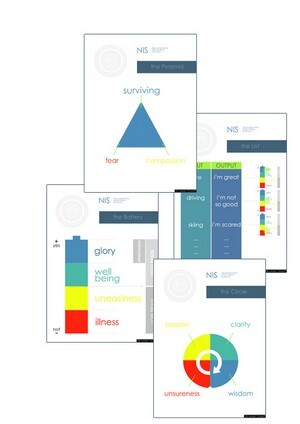
The NIS (Neurodynamic Information Science) Framework is a work environment designated to facilitate Self-Empowerment in both the private and business environments.
Conceptually it is based on 4 schemes that "command" mental training exercises.
It is a wonderful tool to train the most advanced functions of your Mind, to correctly frame what occurs in one's mind, identify the mental mechanisms that generate the events you live, and learn to make the desired events happen through the reshaping of your manner of thinking.
It is a work environment designed by Andrea Mele Motta, Italian Entrepreneur and Business Coach, founder of Thinqua® and co-founder and partner of Ati Group (Ati Formazione srl, Ati Payroll -Professional Payroll srl, Ati Comunicazione srl, SIAL srl).
It all started from a number of extremely intense, challenging and productive personal development activities carried out by Andrea Mele Motta personally, over the course of around 30 years. If you have not already done so, you may find it useful to read the extraordinary BIO at the following link.
In order to understand the wonder that is our Mind, the power one can exercise over life by voluntarily controlling some dynamics that most of us normally do not know how to control, (you normally do not know how/nor to control it), it is essential for you to welcome this concept:
Your identity, or the person you are, is dynamic; "I am like this" is a concept that cannot exist if you want to improve your life.
The more you stand up for who you are, the fewer results your will reap.
It is normal to instinctively defend what and who you are, it is your own natural survival instinct that drives us to defend who we are at any cost.
For this purpose, the NIS Framework, as you will see, starts from the training of this mental function: recognising when your survival instinct takes control and learning to voluntarily operate in a different direction, exactly the one necessary for the realisation of your final goal.
This is possible as our survival instinct only takes over when we "are" a certain person in a certain situation; but if you can literally "be" a different person in that same situation, your survival instinct will have no reason to take over.
This is down to the fact that who you are, your identity, is nothing more than a dynamic set of neurally encoded information in the brain, and you can train yourself to modify this information and recode your identity by re-wiring your neural connections. In this manner, you can have access to otherwise inaccessible experiences; you can render real what you were used to just dreaming of.
In fact, it is your identity, or this dynamic set of information that you can voluntarily modify, that determines your actions; and it is your actions that at the end of the day, determine your ability to reach a goal, or to transform what you used to dream into reality.
Summing up: who you are, and therefore what you do, depends on a set of information which is deeply encoded in your brain:
• change the information that "runs" in your brain and change your identity
• change your identity and change your actions
• change your actions to determine your success or failure
Your success, your personal fullfilment, the life of your dreams, are not the result of chance, but the consequence of the information that "runs" in your brain. You can truly hack your life, uncover its hidden mechanisms and take responsibility for your destiny. On the other hand, you can become an unaware victim of dynamics that you do not understand and cannot control. The choice is yours.
By using the NIS Framework as a training tool for some advanced functions of your Mind you can easily determine:
• when it is necessary to voluntarily intervene through the ability of identifying the alarm bells of the survival instinct
• what information needs to be changed and on which pattern to achieve a specific goal in your life
• what experience you need to look for and which ones you need to avoid in order to train yourself to modify this information
• what outstanding assets you have and how you can "move" them from one identity to another
• what information to decode to enter a hyper-performing state of Mindfulness
NIS is a very simple and powerful Framework, as it allows you to complete these activities on the basis of mental training with only 4 schemes:
• the Pyramid
• the Battery
• the List
• the Circle
Your journey to discover the wonder of your mind starts here; train yourself each day in order to render real what previously appeared to be magic: this simply means making what seems impossible, possible.
Read how to use the first pattern, The Pyramid, to train yourself to identify your alarm bells.
Copyright 1999-2021 Thinqua® - All rights reserved
1.NIS: the Pyramid
_________
what it describes and how to use it to the best of your advantage
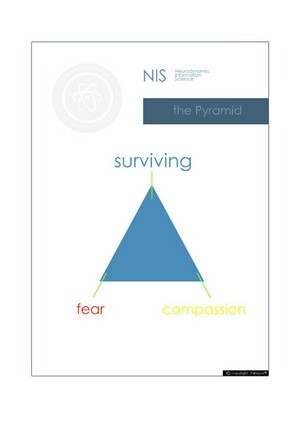
The Pyramid describes the operation of the most primitive "automatic security system" you have to limit your actions and protect yourself, the Survival instinct, and the dynamics this system uses to fulfill its purpose: to ensure your survival at any cost.
The survival instinct is a function of the lower brain, the older part of our brain; it is a rather primitive function.
The survival instinct is not ethical, it is neither moral, nor finely emotional, much less empathetic.
These functions are operated by newer parts of the brain.
The survival instinct is instead an excellent and elementary automatic security system that works more or less as follows: when it registers a stimulation that is perceived as a threat it takes control of your actions and clearly makes you do 2 things that guarantee your survival.
Any other function of your brain, including your rationality, your emotionality, your intelligence, etc, become a tool of your survival instinct when it is in charge; they serve to fulfill its purpose of ensuring your survival, but not eventually to accomplish your goals.
The survival instinct exists to protect every part of yourself, including those wonderful neural connections that encode the information that make you the person you are: your identity. And since it is an elementary system, it has no distinctions. This means that for your survival instinct to register a danger to the survival of your body, for example a car that does not stop while trying to cross the road, or to register a danger for the survival of your identity, for example another human being who attacks what you are or what you may think, is the same thing.
Either way it takes control and commands a series of restorative actions that ensure the survival of your body or identity.
Your survival instinct "oversees" everything and takes over to enable the pure survival of your body or to safeguard the survival of your very own Identity.
With the Battery, in the next chart, we will understand what are the stimuli that are perceived as a threat and activate the survival instinct. With the Pyramid we are interested in highlighting what are the 2 things that the survival instinct makes you do and with what tools, so as to recognise them. These are the alarm bells we touched upon during the introduction to the NIS Framework; being trained to recognise these alarm bells is the first necessary step to access the most advanced functions of your mind and hack your life.
Since the engine of every action is an emotion, this is information that expresses a need and is automatically generated by your unconscious, the survival instinct expresses the need to react to a threat by making you feel an emotion first, the most primitive one: Fear.
Following this, in regards to the values attributed to a threat, which can be stronger or weaker than yourself, there is no doubt that commands and actions are needed which ensure that you perceive the threat in 2 ways: either as a Victim or as an Aggressor (reaction such as run-away / attack).
In order for the threat to perceive you as a Victim or an Aggressor, it is necessary for it to feel specific emotions towards you. Your survival instinct therefore commands these actions that serve to make your threat feel 2 emotions:
compassion, if you must be perceived as a victim, or fear, if you must be perceived as an aggressor.
The Survival Instinct therefore uses 2 emotions to ensure your survival:
• Fear
• Compassion
These are the 2 emotions that you unconsciously stimulate in others when you feel threatened, both physically and in your Identity, to gain control and guarantee your survival, at every level of your existence.
Please note that this dynamic, has no ethics, morals, fine emotions, empathy. It is a primitive dynamic that acts beyond any value, for this reason it triggers the worst of actions, if it is not voluntarily controlled.
The Pyramid in daily practice:
1) Whenever you feel Fear, stop, say the word "wait" in your mind; it will be enough to temporarily break the control of your survival instinct. This momentary pause will give you the opportunity to voluntarily intervene on some parameters: regain control, have a moment to evaluate the whole situation and stop any action or any word you were about to say, start to control and slow down your breathing, smile.
2) Whenever you feel anger, you want to humiliate someone, you want to criticise the person in front of you, render them guilty or unable, stop, say the word "wait" in your mind; it will be enough to temporarily break the control of your survival instinct. This momentary pause will give you the opportunity to voluntarily intervene on some parameters: mentally repeat to yourself that you do not want to hurt the person in front of you, that you do not want to cause that person pain, that you do not want to hurt someone, that each of these things are a bad thing, and you do not want to be a bad person. You will feel guilty about what you were about to say or do. Well, that is nothing but a positive sign.
3) Whenever you wish to be pitied, you enter the frame of mind that you wish others to sacrifice themselves for you, you would be happy to put your burden on other people's shoulders, you want the attention of others, stop, say the word "wait" in your mind; it will be enough to momentarily break the control of your survival instinct. This momentary pause will give you the opportunity to voluntarily intervene on some parameters: mentally repeat that you want to have the attention of others because you are doing something extraordinary, and not due to the fact that you have a problem; that if you cannot get what you want from others it is wrong to try to get it through pain, as it is a constraint that you impose on others. You will feel a sense of annoyance towards yourself for what you were about to say or do. In reality this is nothing but a positive sign.
Try to recognise these 3 alarm bells (fear, anger and the desire for compassion) in your daily life, and train yourself to react as above.
When you can do it regularly and with little effort, you will be ready for the next step, the Battery.
Copyright 1999-2021 Thinqua® - All rights reserved
2.NIS: the Battery
_________
what it describes, how to use it
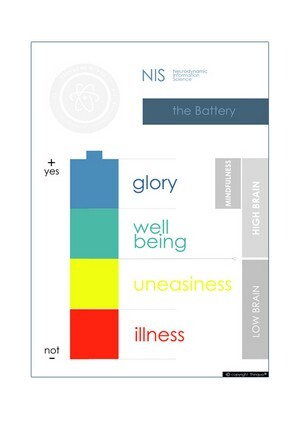
We have now seen with the Pyramid that your survival instincts take over when it perceives a threat to the survival of your life and / or your identity.
With the Battery we define why a certain stimulation, be it an experience or a relationship with another human being, is perceived by your survival instinct as a threat.
Your survival instinct perceives a stimulus as a threat when it does not find the resources it needs to provide a positive response - a response that guarantees your survival.
For example, jumping from one side of a 2-meter-wide ravine to the other is a threat to your survival if you are not an accomplished athlete, or if you do not have the necessary resources to successfully face this experience. On the other hand, if you have the necessary resources, for example you are an Olympic long jump champion, jumping from one side of that ravine to the other is not a threat to your survival; indeed, it is an opportunity for success that allows you to demonstrate your worth.
The experience itself can be registered as a threat or as an opportunity for success; it all depends on the resources you have to deal with.
The perception of a threat to your survival is therefore the consequence of a lack of specific resources necessary to face this: a simple example is the lack of training and a successful long jump experience.
We can go deeper and define what lack of resources means.
The lack of resources with respect to an experience is information encoded in your brain in the form of negative memory of the experience itself or in the form of absence of memory (never lived experience).
In both cases the survival instinct reveals a lack of resources related to such an experience.
In the first case it can also detect a trauma associated with the experience itself.
Going back to the ravine jumps as a pure example, your survival instincts query the database in your brain to see what information is encoded related to such an experience:
• if the memory of the Olympic long jump champion is encoded, your survival instinct detects a sufficient quantity of resources and therefore does not detect any threats; it does not take control and remains on standby in the role of Supervisor, letting the action be conducted by your conscious way of thinking.
• if a negative memory is encoded, or you have no recollection of such a memory, this signifies that the experience is new, your survival instincts do not detect sufficient resources and therefore detect a threat; the survival instinct in automatic takes control and acts by becoming the Director of your actions, and hence, removing all of your conscious part out of action.
The level of resources you have for each experience is represented in the NIS Framework by the Battery; you have one for each experience you are confronted with, be it a practical experience or a relational one.
The Battery is recharged with "YES" and discharged with "NO"; you accumulate resources if you register a "YES", confirmations, positive feedbacks; you consume resources if you receive a "NO", as negative feedback.
The Battery’s charge level defines the number of resources you have in a certain area of your life.
As the List provided demonstrates, we have as many Batteries as there are INPUT / OUTPUT associations that define each and every personal identity.
Different “states” of operation correspond to a different charge level of the Battery itself.
These "states" of functioning define one's behaviour, how you feel and your performance in the long run.
It is the charge level of the Battery related to a specific experience that defines its trend; guarantees your success or decrees your failure.
The Battery is essential for hacking your life; quite simply, only by acting with charged batteries in the areas of your interest will someone be of success in these areas, and only by learning how to "move" charged batteries from one area of your life to another can you be able to access experiences that would naturally be inaccessible to your identity.
In a nutshell, when you act with a Battery that is in the 2 lower states of charge your survival instinct commands (it is the Director of your actions i.e., the Lower Brain); when instead you act with a battery that is in the 2 highest states of charge your survival instinct is limited to observing, it is the Supervisor of your actions (Upper Brain).
When you act with a Battery that is in its highest state of charge, the state of Glory, you experience Mindfulness, or the state of maximum performance of your Mind: you exist only in the present, your senses are focused and super-specialised, you perceive every detail, simultaneously and neatly, your Mind is empty, bright, lucid, 100% committed to the actions you are carrying out.
You are joyful, in harmony, open and communicative.
To learn how to move Charged Batteries from one area of your life to another, you must first identify how you feel when dealing with a Charged Battery. We stated above what are the typical sensations that you experience when you act with a battery at the maximum of its charge, but it is necessary now for you to think about yourself and apply these rules and advice on yourself.
The battery in daily practice:
1) Please bear in mind a situation in your life, where you achieved fantastic positive feedback. A victory in a sports' tournament, the first kiss with a partner you longed for, possession of an object you have long desired, passing an exam, an artistic composition you have made, recognition for helping someone, etc. Any experience in which you have recorded confirmation of your true worth. The fact that you are alive, whoever you may be and whatever you do, is the proof that those moments exist in your life; otherwise, you would only have dead batteries. This is suffice to say, that if this is the case, you would not have enough energy to overcome the challenges of life. in essence, if you do not find these moments, it means that you are not looking in the right place/or deeply enough, you must search further.
2) A good idea, is to write down in words, on a piece of paper who and how you are and what you believe when you live one of these moments: as an example:
What is your opinion/point of view on life? How do you see yourself? Are you interested/concerned about other peoples' opinion or judgement of you? If someone criticises you, do you feel bad or do you smile? If someone does something you do not like, do you criticise them or do you tell them kindly? What is your appearance like? What is your smile like? Are you brave enough to dream or do you feel like you have given up?
3) Read through once more what you have written, several times, and every time you read it back to yourself, try to relive those feelings and emotions more intensely, that vision of yourself and of life; try to revive that mood. Try and get that smile back on your face, you deserve it!
Always carry the paper with you, repeat this exercise several times a day. When you can easily relive these same sensations on command, you will be ready for the next step, The List.
Copyright 1999-2021 Thinqua® - All rights reserved
3.NIS: the List
_________
what it describes, how to use it
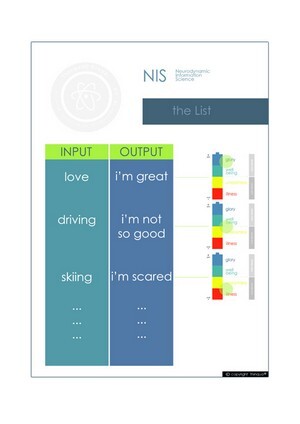
To be more precise, we have kindly asked you all to provide your feedback on your survival instincts, both positive and negative or no feedback at all.
To achieve this, every experience you live is encoded by your brain as an INPUT, whilst the sum of the relative feedback accumulated in your life is encoded as an OUTPUT.
In the face of every experience that you live, your survival instincts then queries its database, searches for the INPUT corresponding to the experience you are experiencing and reads what is written in the OUTPUT. In relation to what it reads, it takes or lets go of control.
A very long list of INPUTs corresponding to the experiences you have lived is therefore encoded in your brain, and for each of them an OUTPUT is encoded too, and it can be positive or negative.
In addition to that, every time you approach a new experience, your brain immediately encodes the information describing that experience as a new INPUT, without filling out any OUTPUTs yet (there are no positive or negative feedbacks to encode yet).
This very long list, The List, is your identity.
The List defines you; it defines your values, your thoughts, your behaviours, your choices, your reactions in every single experience and relationship you live. It defines your ability, given the same situation, to perform either a successful action or to feel helpless and therefore fail.
Let's see why the List defines you and represents your identity.
For each INPUT / OUTPUT association of the List there is a Battery that defines the level of resources available to face that specific experience. As we have seen, it is the charge level of the Battery that defines the mental state you are in, and therefore defines your behaviour and the quality of your personal performance.
In short, if a positive memory (OUTPUT) has been encoded in your List corresponding to an INPUT, for example you are facing a ravine that you have to jump (INPUT) and you are an Olympic long jump champion (OUTPUT), then the relative battery for that INPUT / OUTPUT association has a strong charge.
You will vibrate in one of the 2 higher states of the Battery; You will therefore face that experience with a state of mind of well-being, if not glory, which will guide your actions. Under the guidance of that powerful state of mind you will enact very precise and equally powerful behavioural dynamics. Your powerful performance will get you another hit that will further enhance the OUTPUT in that precise association present in your List.
On the contrary, if a negative memory (OUTPUT) has been encoded in your List referring to that INPUT, for example as a child you fell into a ravine and for this reason developed a phobia for the void, then the relative Battery for that INPUT / OUTPUT association is very low. You will vibrate in one of the 2 lower states of the Battery; You will therefore face that experience with a mental state of discomfort, if not fear, which will guide you in your actions. Under the guidance of that helpless state of mind, you will enact very precise and equally helpless behavioural dynamics. Your poor performance will cause you to get another failure which will further de-power the OUTPUT in that precise association in your List.
The dynamics of dependence List - Battery charge / discharge - Mental state - Performance is repeated for each INPUT / OUTPUT association present in your List, or for each single and detailed experience that you live.
The set of these dynamics represented by the List, therefore, defines you as a whole, is your identity. These dynamics, in fact, are the engine of your thoughts, your emotions, your behaviours, your words, and your actions.
These dynamics, defining every aspect of your existence, also define your success or failure.
You cannot produce any positive performance, or achieve success, in the context of an INPUT / OUTPUT relationship whose battery is discharged.
Success in any area of your life is not a matter of luck. It depends on the INPUT / OUTPUT associations that are activated in the achievement of your goal and the state of charge of the relative batteries.
There is only one way to be successful: having charged Batteries that modulate the INPUT / OUTPUT associations involved in achieving your goal.
The List in daily practice:
1) Write your List on a piece of paper; enter the most significant INPUTs of your life, the experiences you usually live at work, in private relationships, in your free time, and then fill in the OUTPUTs, write if compared to each INPUT your performance is high, that is to say, you are good at that thing, or not.
2) For each of the INPUT / OUTPUT associations whose OUTPUT is positive, reproduce exercises 2 and 3 of the Battery.
3) Remain in the mental state that you reproduced with exercises 2 and 3 of the Battery, imagine for each of the INPUT / OUTPUT associations whose OUTPUT is negative how you would act, how you would feel, what you would respond, what meaning would you give to that event, if you relived that situation in this new state of mind. Relive the experience in your imagination in every smallest detail, and "rework" that detail in light of your new state of mind. Imagine how the dialogues, your body, your smile, your gaze, your emotions and your actions would be, in every moment of that experience if it was lived in your new state of mind. Review every detail several times and repeat this step as many times as possible during the day; this is the first step to rewriting your List and hacking your life.
4) Remember carefully what these situations in which the OUTPUT is negative, and when you really live them try to implement every detail of that experience as you reworked it with your imagination in step 3.
When after a long time, failed attempts, and a lot of effort, step 4 will be automatically implemented by your brain, without your conscious intervention, the rewriting process of your List will be successful. You will have changed your identity, and therefore your destiny.
Copyright 1999-2021 Thinqua® - All rights reserved
4.NIS: the Circle
_________
what it describes, how to use it
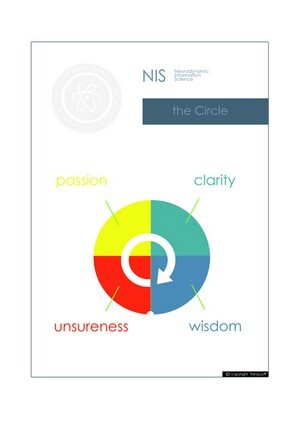
To recap: we have seen with the Pyramid that the primitive engine of all your actions is the survival instinct, and that this engine accelerates autonomously in the direction it desires when it registers a threat. With the Battery we have learned that the threat that activates your survival instinct is represented by any experience that you live without having the necessary resources to guarantee its success, and that the resources are nothing more than positive feedback registered with reference to that 'experience. Finally, with the List we have highlighted how your behaviour is defined by INPUT / OUTPUT associations that creates your identity, and how each of these associations is "modulated" by the charge value of the relative Battery.
The charge level of the Battery determines your ability to react to an INPUT with a powerful or impotent reaction, that is to say, it determines your success, but it also determines the state of Awareness and the level of Freedom you have regarding that INPUT.
Let us see how with the Circle in fact works:
When you first relate to any experience you are at 6 o'clock in the Circle.
You have no resources related to that experience, your Battery is completely dead and you are consumed by insecurity.
The starting point of each process / experience at 6 am, in total insecurity, is quite significant, as it defines that any new process / experience starts in a state of insecurity; if you are not willing to bear this bad feeling you cannot start something new, that is, you cannot change and evolve.
If you do not give up and overcome the first phase of insecurity, statistically you begin to register small positive feedbacks that load your battery. Trust, hold on, it's statistics.
To help statistic, train with the Pyramid, Battery, and List exercises so that you get more positive feedback even if you are still in the first stage of insecurity. Doing so it ensures you have a better chance of climbing the Circle in a reasonable time.
When the first positive feedbacks give you a certain degree of satisfaction and moderately charge your battery, you are passionate about what you are doing. You thus pass from the phase of Insecurity to the phase of Passion, in which more complex emotions than fear move your actions. In both phases, though in a decreasing way, your survival instinct is still the Director of your actions; although you believe you are in control, the engine of your words, reactions and intentions is your survival instinct, unless you can voluntarily operate with another identity.
If you do not abandon that experience (the reasons that lead you to abandonment are the result of the relationship between the desired Identity and available resources) and continue to record positive feedback, even with the help of technique, you take a very important leap in your functioning: you pass from the Passion phase to the Lucidity phase, the first step of access to Awareness, the functional switch from a Lower Brain motor to an Upper Brain motor.
Your survival instinct has entrusted the command to the newer part of your brain, which no longer limits itself to executing the commands of the older part, but chooses what to command.
In the Lucidity phase, for the first time, your survival instinct remains on standby in the role of Supervisor, and you are in real control of yourself. You can, for the first time, check the words you say in real time, choose what reaction to have, what behaviour to adopt, etc. It is a phase of great performance. Already at this stage you can experience Mindfulness. Many human beings who reach this functional level believe they have reached the summit, and remain in this state for the rest of their existence.
The performance in the state of Lucidity is such that it is easy to believe that there is nothing more to improve. In fact, in this phase even the actions commanded by your survival instinct are carried out with such refinement and control that it is difficult to distinguish them from those controlled by your conscious part.
Difficult but not impossible. If you have the desire and determination to "clean" every aspect of your life, if you still feel "annoyance" in certain situations which doesn’t let you sleep peacefully, if despite the Lucidity that animates you and the performance you have achieved you try hard yet to perceive your alarm bells, and when you register them, with humility, accept your imperfection and apologize, then you are on the right path of Wisdom, you are closing your Circles.
Only in the phase of Wisdom are you truly FREE. In the phase of Lack of Self Confidence you are a slave to Fear; in the phase of the Passion you are a slave to the Instincts; in the Lucidity phase you are a slave to your EGO.
As with the Battery, there is a Circle for each INPUT / OUTPUT association of the List.
When you close the Circle, when you work out the entire path of a process / experience and reach the ultimate in Wisdom, you find yourself again at 6 o'clock in the beginning.
Since each phase of the Circle corresponds to behaviours, values, needs / objectives, well defined and common to every human being, the Circle indicates to you that at the apex of your Wisdom you return to adopt those behaviours and to have those needs and values that you possessed at the beginning of the path.
That has a gigantic difference and inestimable impact on your life: at the beginning of your journey those behaviours, needs and values were the expression of your lack; they could not be other than that. At the end of your journey, those behaviours, needs and values are the expression of total fullness; you no longer need to be anything other than that.
The Circle in daily practice:
1) Never give up on an experience because you are afraid of it or because you feel uncomfortable in it. Even if it takes years, close the circle, go through all the phases until you return at 6 o'clock. Only then when you give up that experience you will be sure that it was a free choice, a manifestation of strength that will make you happy.
2) If you are criticized in an activity in which you are very good and it bothers you, enough to answer badly or worse to "plan" a revenge lucidly, stop, do not act in this way. Even if you think you don't need it anymore, start over with Pyramid workouts. Then, as soon as you can accept your imperfection, apologize.
Copyright 1999-2020 Thinqua® - All rights reserved
NIS: conclusions
_________
applicational examples of the Framework
The 4 schemes of the NIS Framework lead to interesting conclusions.
For example, they describe the dynamics of self-sabotage with coherence and clarity.
If we act within an INPUT / OUTPUT association whose battery is discharged, our survival instinct assumes the role of Director in order to ensure the survival of our identity, that is, of that INPUT / OUTPUT association. The survival instinct is a primitive function of the lower brain, it does not have the ability to interpret, it does not have the ability to assess whether what it has to defend, that is the INPUT / OUTPUT association in question, is an association worthy of being defended, saved, guaranteed, or not. If the Battery that describes this association is discharged, the survival instinct is activated, and defends that information contained in that INPUT / OUTPUT association at any cost, whatever they may be.
So, if for example for the INPUT "to be successful" the OUTPUT is "no", because we have followed models that have not transferred confidence in ourselves, in life, in the possibility of being happy, or that have even subdued us and they made us passive, our battery is discharged with respect to that INPUT / OUTPUT association.
Therefore, whenever we find ourselves in situations in which the item "success" is queried in our List (possibility of a job we like, of achieving an important goal, etc.), our survival instinct is activated. And it takes action to do only one thing: protect our identity, that is, protect the information encoded under "success".
Since the coded information is: "no", "impossible", "I'm not the one who can be happy", etc, our survival instinct guarantees the survival of this information.
That is, our survival instinct, which is controlling our actions and behaviours, makes us say things, make choices, take actions, etc, which inevitably lead to our failure. Because that's how it is written in our identity, and our survival instinct can do nothing but protect this identity, that is, it can do nothing but realize it at any cost.
Although it seems to us that we are doing everything to achieve the success we want, unknowingly we are instead putting in place small corrective measures that allow us to fail, that is, that allow our survival instinct to protect the life of that information encoded in our List.
This is self-sabotage.
We cannot get rich as long as our List says we are losers; we cannot have the partner of our dreams as long as our List says that we are not attractive; we can't play tennis well as long as our List says we're not sporty types, and so on.
We cannot achieve any goal that is contrary to the information encoded in our List, because in that case our survival instinct intervenes to produce self-sabotage.
The survival instinct is a proven mechanism, it has existed for millions of years, and it is infallible! We can't beat it; we have to exploit it.
We have to re-code that piece of information that prevents us from achieving our goals; we must write a List that is consistent with our goals; then our survival instinct becomes our best ally, because it does everything to allow nothing or anyone to undermine the existence of that information, or to prevent us from achieving our goals.
The excellent news is that, regardless of our past, we can now rewrite any information encoded in our List.
Success is a positively recoded INPUT / OUTPUT association whose material realization is guaranteed by the survival instinct!
With equal clarity and consistency, the NIS Framework describes other dynamics, including, for example:
• systematically meeting up with problematic friends / partners
• suffering aggression, being aggressive
• failing to say “no” and feeling overwhelmed by events
• being very critical of others
• not being conclusive, starting a thousand things without finishing them
• failing to express their ideas
• having the impression that others are speaking ill of us behind our backs
• always trying to prove our worth
• being afraid of making mistakes
If you are interested in learning more in regards to the original techniques of the NIS Framework to train your Mind, recode your List and hack your life, visit the section dedicated to Thinqua® Courses or buy a book published by Thinqua®
The NIS Framework (Neurodynamic Information Science) and the NIS Schemes are an intellectual property of Andrea Mele Motta protected by a digital time stamp. If you wish to use the NIS Framework for Professional purposes, contact Thinqua® support.
Copyright 1999-2021 Thinqua® - All rights reserved
Train every day the most advanced functions of your mind.
__________
Always carry with you the 4 NIS schemes and repeat these exercises every day!
To download the paper of the NIS Framework, with the 4 NIS schemes and exercises, activate your Thinqua® account for free! You will find the PDF of the Paper in your account, among your Free Resources!
choose what to do:
.



